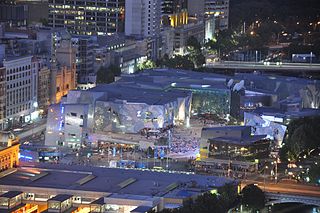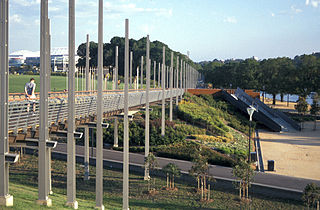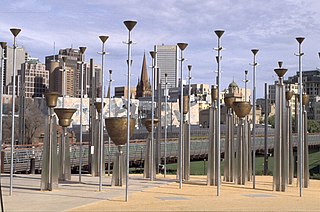
The Yarra River or historically, the Yarra Yarra River, is a perennial river in south-central Victoria, Australia.
The history of Melbourne details the city's growth from a fledgling settlement into a modern commercial and financial centre as Australia's second largest city, Melbourne, in the state of Victoria.

Federation Square is a venue for arts, culture and public events on the edge of the Melbourne central business district. It covers an area of 3.2 ha at the intersection of Flinders and Swanston Streets built above busy railway lines and across the road from Flinders Street station. It incorporates major cultural institutions such as the Ian Potter Centre, Australian Centre for the Moving Image (ACMI) and the Koorie Heritage Trust as well as cafes and bars in a series of buildings centred around a large paved square, and a glass walled atrium.

Docklands, also known as Melbourne Docklands, is an inner-city suburb in Melbourne, Victoria, Australia, 2 km (1.2 mi) west of Melbourne's Central Business District, located within the City of Melbourne local government area. Docklands recorded a population of 15,495 at the 2021 census.

Southbank is an inner-city suburb in Melbourne, Victoria, Australia, 1 km south of the Melbourne central business district, located within the Cities of Melbourne and Port Phillip local government areas. Southbank recorded a population of 22,631 at the 2021 census.

Heidelberg is a suburb of Melbourne, Victoria, Australia, 11 kilometres (7 mi) northeast of Melbourne's central business district, located within the City of Banyule local government area. Heidelberg recorded a population of 7,360 at the 2021 census.

South Yarra is an inner-city suburb in Melbourne, Victoria, Australia, 4 km south-east of Melbourne's Central Business District, located within the Cities of Melbourne and Stonnington local government areas. South Yarra recorded a population of 25,028 at the 2021 census.

Moomba is held annually in Melbourne, Australia. Run by the City of Melbourne, it is Australia's largest free community festival. The Melburnian tradition is celebrated over four days, incorporating the Labour Day long weekend, from Friday to the second Monday in March. Moomba is culturally important to Melbourne, having been celebrated since 1955, and regularly attracts up to a million people, with a record attendance of 3.8 million set in 2018.
The Melbourne Convention and Exhibition Centre (MCEC), colloquially referred to as Jeff's Shed, is a group of three adjacent buildings next to the Yarra River in South Wharf, an inner-city suburb of Melbourne, Victoria, Australia. The venues are owned and operated by the Melbourne Convention and Exhibition Trust.
Yarra Scenic Drive is a tourist drive following the Yarra River, in Victoria, Australia. The route traverses approximately 60 km from Williamstown – where the Yarra empties into Port Phillip Bay – to Warrandyte – Melbourne's first goldfield site on the banks of the Yarra.

Birrarung Marr is an inner-city park between the central business district in Melbourne, Victoria, Australia and the Yarra River. It was opened in 2002. The name refers to the bank of Birrarung, the 'river of mists', in the Woiwurrung language of the Wurundjeri people, the Indigenous inhabitants at the time of European colonisation of the Melbourne area.

Melbourne is Australia's second largest city and widely considered to be a garden city, with Victoria being nicknamed "the Garden State". Renowned as one of the most livable cities in the world, there is an abundance of parks, gardens and green belts close to the CBD with a variety of common and rare plant species amid landscaped vistas, pedestrian pathways, and tree-lined avenues, all managed by Parks Victoria.
Deborah Halpern is an Australian sculptor, mosaic artist and ceramic artist, notable for her public artworks in Melbourne.
Sir Roy Burman Grounds was an Australian architect. His early work included buildings influenced by the Moderne movement of the 1930s, and his later buildings of the 1950s and 1960s, such as the National Gallery of Victoria and the adjacent Victorian Arts Centre, cemented his legacy as a leader in Australian architecture.

Centre Place is a laneway and pedestrian precinct in Melbourne, Australia. It runs north from Flinders Lane to Collins Street, between Elizabeth Street and Swanston Street.
Postcode 3000 was a planning policy for Melbourne, Australia coordinated by the City of Melbourne and supported by the state government, under newly-elected Premier Jeff Kennett. The policy, which began in 1992 and ran throughout the 1990s, was aimed at increasing residential development in the Melbourne central business district and St Kilda Road. At the time, these areas were primarily business districts and had low residential populations.

Federation Bells is an installation comprising 39 upturned bells. Located in Birrarung Marr, Melbourne, they were created for celebrations of the centenary of Australia's federation in 2001. They were designed by Anton Hasell and Neil McLachlan in collaboration with Swaney Draper Architects. To achieve the acoustical tuning of the bells, Behzad Keramati Nigjeh, an aerospace engineer, also cooperated in this project. The bell's vibration modes were modelled and optimised using a sophisticated Finite Element software developed by Dr Joe Tomas.

Melbourne is the capital of the state of Victoria and the second-most populous city in Australia, although the most populous by contiguous urban area. Its name generally refers to a 9,993 km2 (3,858 sq mi) metropolitan area also known as Greater Melbourne, comprising an urban agglomeration of 31 local municipalities, although the name is also used specifically for the local municipality of City of Melbourne based around its central business area.
Jillian Meredith Garner is an Australian architect. She is a principal of Garner Davis Architects and in 2015 became the Victorian Government Architect.
The Melbourne Prize is an Australian architectural award. It is awarded annually at the Victorian Architecture Awards by a jury appointed by the Victoria Chapter of the Australian Institute of Architects to architectural projects that have made a significant contribution to the public life of Melbourne, Australia. It was first awarded in 1997 to Six Degrees Architects for the small bar Meyers Place.












